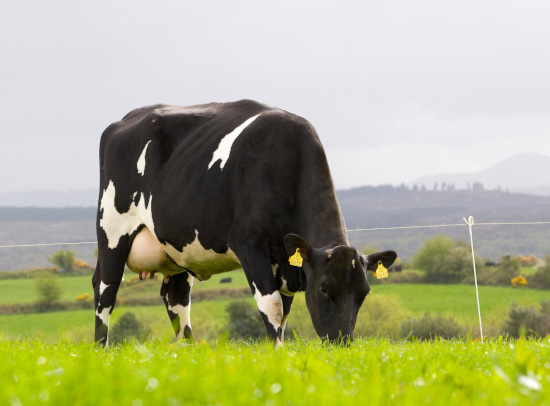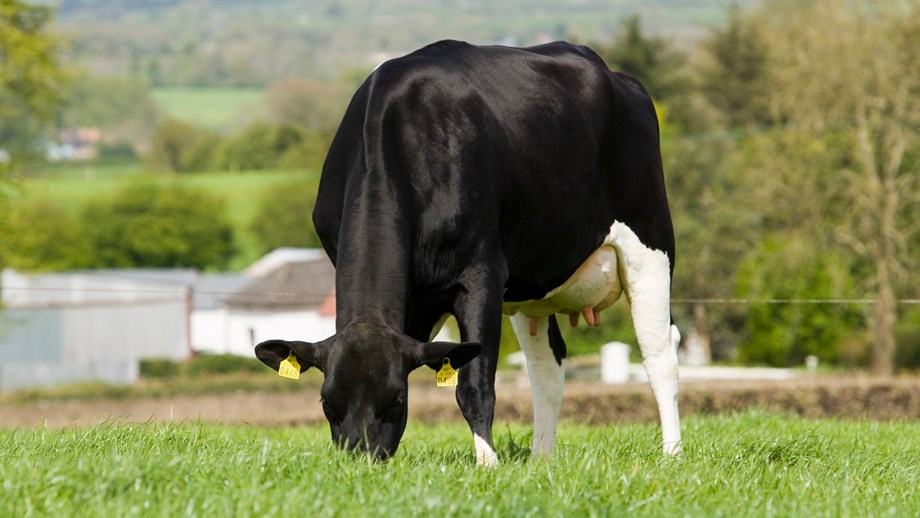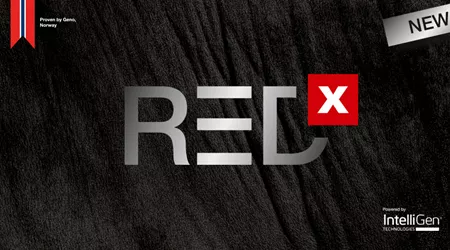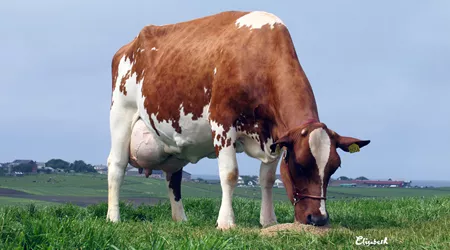Geno has been partnering with Dovea Genetics in Ireland for the past 10 years. As the dairy industry continues to grow in this unique landscape, progressive dairy farming in Ireland has also received much attention and caught the eyes of dairy farmers globally.
To understand what makes dairy farming in Ireland unique, we met with our partner, Dovea Genetics, and spoke with Niall Duffy, the company’s Dairy Programme Manager & Sire Analyst to get insights on the dairy industry in Ireland and how Norwegian Red genetics has been a part of the success of Irish dairy farmers.
About Niall Duffy
Niall Duffy is the Dairy Programme Manager & Sire Analyst at Dovea Genetics, an Irish bull stud and semen supplier and the proud Irish partner of Geno as the exclusive distributor of Norwegian Red genetics throughout Ireland. Niall has been a part of the Dovea Genetics Dairy team since March 2021 managing the young bull genomics programme, focusing on planned testing and specialized matings.

Niall has a background in dairy production and dairy research. He graduated from University College Dublin (UCD) in 2018 with a degree in Dairy Business. He comes from a dairy farm in Co. Monaghan, where his family currently milks 60 dairy cows in a medium output spring-calving grazing system. Niall works on his home farm on the weekends and believes that the set-up has benefitted him in his current role with Dovea Genetics.
The Dairy Industry in Ireland
Over 18,000 dairy farmers milk Ireland’s 1.55 million dairy cows. Ireland's temperate climate enables Irish dairy farmers to grow large quantities of grass and use this grass as a low-cost feed resource producing a seasonal milk supply. This advantage makes dairying the most profitable of Ireland’s mainstream agricultural enterprises. In 2021 the average herd size has increased to an average of 91 cows with an average size of 64 ha.
The majority of farmers in Ireland employ a spring calving grass-based system where cows graze between 240-300 days per year depending on stocking rate, annual growth, and soil quality. There are various farm systems in Ireland however almost all farmers use grass or conserved grass as the main source of feed.
Block calving system
Block calving systems are very popular in Ireland intending to match the herd intake with the typical grass growth supply curve beginning in the spring. It is well established that fertility has the largest impact on the overall success of the block calving system due to the increased average days in milk while also allowing the herd to naturally mature therefore pushing output. Fertility in Ireland has improved significantly in the last 20 years. The block calving system matches well with the family farm structure bringing labor and feed efficiency benefits. The majority of milk processors in Ireland are co-ops and the farmers are paid through a manufacturing milk price payment system.
Fertility has the largest impact on the overall success and has improved significantly in Ireland the last 20 years. The block calving system matches well with the family farm structure bringing labour and feed efficiency benefits.
Approximately 84% of Irish dairy cows are calved each year between January to April. The goal of pasture-based farming is to calve the cows every year to match the cows' peak milk production with the peak grass production. Cows typically are maintained outdoors during the grass growing season which is typically more than 240 days per year with some farmers reaching 300 days on the better soils.
The relative cost of pasture as a feed source for livestock production compared with grass silage and concentrates has been reported as 1:1.8:2.4 respectively. Research in 2017 showed that Irish dairy farms had the second lowest cash costs per kg of milk solids in the EU which is a result of the grass-based production system and ideal grazing conditions.
Research in 2017 showed that Irish dairy farms had the second lowest cash costs per kg of milk solids in the EU which is a result of the grass-based production system and ideal grazing conditions.
The abolition of EU milk quotas has resulted in a rapid expansion in both dairy cow numbers and production per cow in Ireland contributing to a 47% growth increase in annual milk solid production since 2015. The Irish government published an ambitious strategy for the agricultural sector in the year 2010 that aimed at growing the value of the agricultural sector's output by 33% by 2020 relative to the average position in the 2007-2009 period.
Sustainability for efficient and profitable dairy farming
The agricultural sector now faces a new challenge to reduce overall GHG emissions by 25% by 2030. Greenhouse gas emissions associated with the production of food are lower in grazing systems and the utilization of more grass will help lower the emissions of the Irish dairy industry. There is also an opportunity to help meet these ambitious targets through improved genetics in the Irish herd. Increases in efficiency and profitability can be achieved at the farm level through using the right genetics to improve dairy cows' productivity and fertility.
Greenhouse gas emissions associated with the production of food are lower in grazing systems and the utilisation of more grass will help lower the emissions of the Irish dairy industry
Appropriate genetics for pasture-based systems in Ireland is the reason the Economic Breeding Index, or EBI, was developed to suit the Irish environment and Irish payment system. There is a requirement that resilient animals capable of efficient production of milk solids, combined with high fertility performance, are suitable. Hence the importance of the individual trait of fertility is greater in seasonal systems of milk production, compared to non-seasonal systems. This to maximize the use of grass and labor efficiency in the dairy cow.
There are huge opportunities for Irish farmers to continue to increase farm profit through genetics. The breeding policy in Ireland is geared toward maintaining liters supplied per cow while improving percentages and total milk solids. Many farms now reach 500kg milk solids on >1000kg of concentrate per cow.
“The Norwegian Red breed in Ireland has recorded strong genetic progress on milk component percentages, production and conformation traits as well, at the same time improving fertility and health even dairy strength”.
There is an increased demand for sexed semen in Ireland each year because of its financial benefits, in terms of calf price, along with the genetic gain through breeding from the best females. The challenge to maintain fertility targets while incorporating sexed semen is always the challenge for Irish dairy farmers.
Crossbreeding in the eyes of Irish dairy farmers
Crossbreeding is becoming increasingly popular in Ireland, particularly on the larger dairy farms because of the benefits it brings in terms of fertility, cow health, and longevity. Crossbreeding in general, especially two-way crossbreeding using Norwegian Red is still considered a relatively new innovation in Ireland by most dairy farmers.
Crossbreeding is becoming increasingly popular in Ireland, particularly on the larger dairy farms because of the benefits it brings in terms of fertility, cow health and longevity.
The Irish Holstein-Friesian is the most common breed in Ireland. The Holstein Friesian is a combination of pure Holstein and pure Friesian bloodlines traditionally with an 80:20 split which means the cows are not extreme for milk production or stature.
The EBI, which is the Irish national index, has the biggest influence on farm breeding strategy on Irish farms. It is the tool used to identify suitable genetics for Irish pasture-based production systems. The Economic Breeding Index (EBI) has been in effect in Ireland since the year 2000 with many additional traits added and weightings changed and it’s made up of seven sub-indexes which are (1) milk production, (2) fertility (3) calving performance (4) beef carcass, (5) cow maintenance (6) cow management and (7) health.
The growing demand for Norwegian Red genetics in Ireland
Niall has experienced many farmers focusing their sire selection on the areas they wish to improve the most. "Now and for the foreseeable future, the important traits for Irish farmers are milk components and health".
There is now a national awareness around the challenge of Antimicrobial Resistance (AMR), and with new EU laws banning the use of blanket dry cow therapy, dairy farmers and industry are taking a proactive approach to reduce the number of antibiotics used on farms. A large amount of the antibiotics used on Irish dairy farms are used to treat or prevent mastitis. Breeding a cow that has a greater resistance to developing mastitis with a lower somatic cell count (SCC) poses opportunities to reduce antibiotic use, which has societal benefits and financial benefits for the farmer. The Norwegian Red sires offered by Dovea Genetics, transmit increased additive health benefits on our health index too.
Fertility & health leads to improved total Milk Solids production and longevity. Herds now using Norwegian Reds are getting 5+ lactations from their cows. They have an excellent calving interval with more than 90% calving in the first 6 weeks of the season next spring, which is essential for a spring calving system.

The Norwegian Reds are also superior in their maintenance figure, which is a predictor of mature live weight. Selecting lower body weight through the € value maintenance index will subsequently reduce the feed needed for the maintenance of routine bodily functions. Along with this, farmers are beginning to take a look at the Norwegian Feed$aved index, which is a trait that has been carefully developed to help customers select for reduced dry matter intake requirements while also selecting for higher production, resulting in increased feed use efficiency.
It is commonly known that a cow needs to be able to handle pressures associated with the challenges presented by Irish pasture-based systems. This includes energy expenditure associated with walking and grazing activity, variability in seasonal weather conditions along with fluctuating feed supply in terms of both qualities of grass and availability. This is where the Norwegian Red cow stands out. This means we are breeding for a cow that has a more consistent milk solid supply curve rather than a cow that has a huge peak production that does not last.
The trends of sexed semen and "beef on dairy" in Ireland.
"Beef on dairy is a no brainer, it offers huge financial benefits for both the dairy and the beef farmer which is important. With this in mind, breeding enough elite dairy replacement heifers should still be the number one goal".
We have seen a huge increase in demand for sexed semen during the 2022 breeding season, especially on heifers. Sexed semen usage in Ireland is significantly lower by comparison to other countries mainly due to the pressures of the confined breeding season. This year we have seen very promising non-return rates using Geno’s REDX (Norwegian Red sexed semen). There is a huge opportunity for Norwegian Red and Irish farmers to deliver REDX that delivers above-average sexed semen conception rates. We are looking forward to seeing the relative conception rates of Norwegian Red genetics.
Future expectations of Irish dairy farmers
I think an integrated and balanced breeding trait approach should be used when it comes to breeding the cow of the future. The overall question for farmers is "how can we increase production efficiency and environmental sustainability at the same time?". Everyone is aware that we need to take steps to become net zero in terms of our carbon footprint. We also want to stop our dairy cows from getting bigger or at least maintaining their size while improving production. There is a maintained cost associated with every kg a cow is heavier.
Breeding cows with lower feed requirements will not only reduce feed costs but lower their environmental impact and improve the farms' financial sustainability.
Genetic selection will play a significant role in reducing the carbon footprint per kg of milk solids that leaves the farm. We want the cows to be as efficient as possible. The biggest contributor to the footprint is methane and through that, we want to address it in breeding. The methane evaluations across the world are in their infancy and cannot be measured directly but there are traits in my view that contribute to this.
The first is the cow's life span and lifetime production. The lifetime yield of a cow is a combination of measures of production, fertility, and functionality. We can breed for cows that have a good lifetime yield and also select sires that have the desired traits to transmit to the next generation. Most farmers are already selecting for this however, I think. I know it can be tempting for farmers to incorporate the hot new genetics each year however in my view the replacement rate should be aimed at 15-20%.
We need to maintain productivity and improve our percentages this will also improve feed efficiency. Genetic improvements are permanent, and we can intervene by having more efficient cows. I also think genomic testing on females is going to be important for all.
Key traits to consider when selecting Norwegian Red sires for the Irish market
We work very closely with our Geno Regional Manager Diego Galli, his recommendations are important because he understands what is suited to our system. A combination approach, of course, is an index with no faults in the country of origin. Along with this EBI conversion is important too and normally consistent with the Norwegian index. There are some very high EBI-daughter-proven sires in the top 10 daughter-proven EBI list. The most interesting traits are components, total solids, health, fertility, feed saved, and correct linear conformation.
The best part about your job
I love working with dairy cows and the art of breeding. I am privileged to be in my role with Dovea Genetics, it’s a fantastic organization. I like the opportunity to put knowledge and experience into practice and have a positive impact on not only individual farmers but also the Irish dairy industry as a whole. I would like to take this opportunity to thank Geno for its extensive support and elite offering of dairy genetics. It’s a very exciting time for dairy farmers with huge opportunities to continue to improve.



